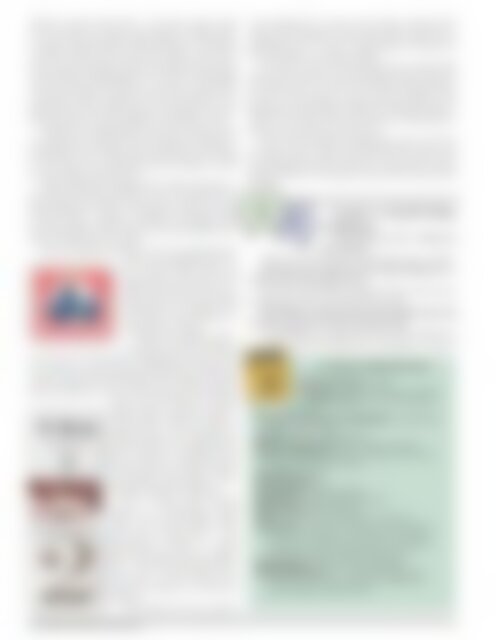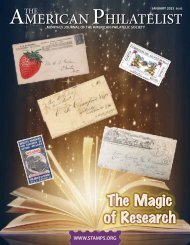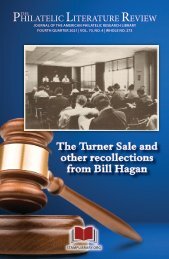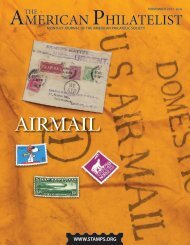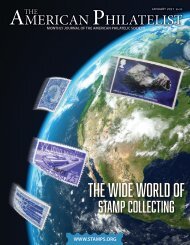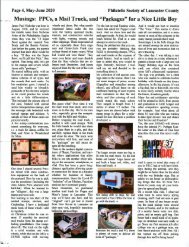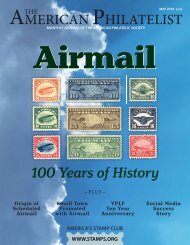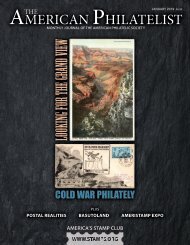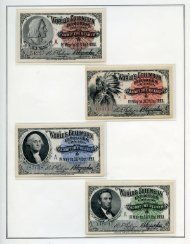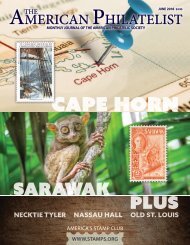August 2018 - Sneak Peek
The American Philatelist is the monthly journal of the American Philatelic Society, the world's largest organization for stamp collectors and enthusiasts. Members receive the printed magazine and can access the digital edition as a benefit of membership in the Society. Please enjoy this sneak peek. We're confident that once you see all that we offer, you'll want to join the APS today.
The American Philatelist is the monthly journal of the American Philatelic Society, the world's largest organization for stamp collectors and enthusiasts. Members receive the printed magazine and can access the digital edition as a benefit of membership in the Society. Please enjoy this sneak peek. We're confident that once you see all that we offer, you'll want to join the APS today.
You also want an ePaper? Increase the reach of your titles
YUMPU automatically turns print PDFs into web optimized ePapers that Google loves.
Thomas Crawford (1814-1857). The bronze statue stands<br />
19½ feet high and weighs approximately 15,000 pounds.<br />
Crawford, commissioned in 1854, died before a full plaster<br />
cast left his studio in Italy in 1858. The statue was cast in five<br />
main sections starting in 1860 by Clark Mills in his foundry<br />
on the outskirts of Washington, D.C. As the Civil War raged,<br />
work on the Capitol, then under construction, and the statue<br />
continued. By 1863, enough of the structure had been completed<br />
so the statue could be placed. It was hauled in sections<br />
and raised atop a cast-iron pedestal on December 2, 1863.<br />
Chad Snee, managing editor for the Scott catalogs, spoke<br />
at the dedication ceremony about his affinity for stamps denominated<br />
at $1. He often writes articles about such stamps<br />
in Linn’s Stamp News, which like the Scott catalogs, is owned<br />
by Amos Media, of Sidney Ohio.<br />
Mike Golemboski, manager of Post Office Operations in<br />
the Western Pennsylvania District of the U.S. Postal Service,<br />
offered dedication remarks. The National Anthem was sung<br />
by Maya Fulton, a student at Bellefonte Area High School<br />
and a presentation of the colors was from the Bellefonte Veterans<br />
of Foreign Wars Post 1600.<br />
The new stamps are similar to the 1923 engraved issue,<br />
which was designed by Clair Aubrey<br />
Huston (1857-1938) and<br />
engraved by John Eissler (1873-<br />
1962), both of the U.S. Bureau of<br />
Engraving and Printing. USPS<br />
art director Greg Breeding designed<br />
the new stamps.<br />
Before the ceremony, Mary-<br />
Anne Penner, director of Stamp<br />
Services for U.S. Postal Service headquarters and four others<br />
involved in stamp creation and distribution, spoke and<br />
answered questions with attendees at the summer seminar.<br />
Penner said there are four or five printing security features<br />
within the new Statue of Freedom<br />
stamps. Penner noted that such security<br />
features, which she could not<br />
elaborate upon, were standard features<br />
in the latest U.S. stamps with the<br />
goal to prevent counterfeiting. The<br />
security features are “layered” within<br />
the printing, noted William Gicker,<br />
manager of stamp development<br />
One of those easily detected<br />
features is microprinting found<br />
below “USA” on the stamps’ righthand<br />
side. Printed below is the<br />
denomination spelled in capital<br />
letters five times with no spaces,<br />
thus “TWOTWOTWOTWOTWO.”<br />
Also, there is a small “USPS” in the<br />
color of the stamps on Freedom’s left<br />
shoulder.<br />
Linn’s Stamp News also reported<br />
“color-shifting ink” is found on the stamps. Looking at the<br />
stamps, this ink appears to have been used to print the denominations<br />
of “1,” “2” and “5,” which appear to change color<br />
when the angle of the stamp is shifted.<br />
The June 27 event was the third first-day ceremony held<br />
by the U.S. Postal Service in Central Pennsylvania. A first-day<br />
was held January 23, 1986 for the Stamp Collecting booklet<br />
(four 22-cent designs), a joint issue with Sweden, at APS<br />
headquarters, then in State College. The Nonprofit Lamb envelope<br />
(5-cent value) first day was March 10, 1995 at the Nittany<br />
Lion Inn at Penn State University.<br />
The $1 and $2 stamps are being sold in panes of 10; the<br />
$5 stamp in panes of four. The Postal Service’s online store<br />
was allowing the purchase of blocks of four of the $1 and $2<br />
stamps, but there was no option except a block of four for the<br />
$5 stamp.<br />
Q and A, Greg Breeding,<br />
art director<br />
When did you start working on<br />
these stamps?<br />
I began work on this project during the summer of 2016.<br />
These three new stamps use the original engraved artwork<br />
for the 1923 stamp, correct?<br />
They were inspired by the original artwork, but the original<br />
engravings were not used for these stamps.<br />
Were there any enhancements to the original engraving<br />
for these stamps? If so, what would those be?<br />
A photoengraver worked with a scan of the original artwork<br />
and employed his techniques to create a<br />
$1 STATUE OF FREEDOM STAMP<br />
USPS Item Number: 114200<br />
Format: Pane of 10, 120 stamps per revolution<br />
Issue Date & City: June 27, <strong>2018</strong>, Bellefonte,<br />
Pennsylvania<br />
Designer, Art Director and Typographer: Greg Breeding,<br />
Charlottesville, Virginia<br />
Modeler: Sandra Lane/Michelle Finn<br />
Manufacturing Process: Offset, Intaglio, Microprint<br />
Printer and Processor: Banknote Corporation of America,<br />
Browns Summit, North Carolina<br />
Press Type: Alprinta 74<br />
Stamps per Pane: 10<br />
Print Quantity: 100 million stamps<br />
Paper Type: Phosphor Tagged Paper, Block<br />
Adhesive Type: Pressure-sensitive<br />
Colors: Custom Green, Custom Black, Custom OVI<br />
Stamp Sizes: 1.42 inches by 1.085 inches, 36.07 millimeters<br />
by 27.56 mm (image area); 1.56 inches by 1.225 inches,<br />
39.62mm by 31.12mm (overall size); 4.85 inches by 8.27<br />
inches, 123.19mm by 210.06mm (full pane size)<br />
Plate Numbers: B followed by three single digits<br />
Marginal Markings: Front – Plate block number; Back –<br />
©<strong>2018</strong> USPS, USPS logo, 10 Barcodes (114200), Plate<br />
position diagram, Promotional text<br />
810 AMERICAN PHILATELIST / AUGUST <strong>2018</strong>


